Wawazat;230335 wrote: Now that I think about it myself, there will be less torque applied using an extension due to the uncalculated torsional deflection of that extension. I do not think that it will be substantial, however I do think that it would be different. Am I wrong?
I thought about the torsional deflection a bit, and I don't think the pure torsional deflection, regardless of magnitude, will have any effect. Here's why:
Let's take, for a simpler example, two regular old springs: one soft and one stiff. You put each spring on your bathroom scale and apply 100 pounds of force. The stiff spring deflects very little, while still transferring 100 pounds of force to the scale. It has to transfer all 100 pounds due to equal and opposite reactions. However, the soft spring, while it deflects much more, still transfers all 100 pounds.
Now, let's apply the same thinking to pure torsional deflection. Lets say we have a steel rod and a wooden rod of the same length and diameter. We then apply 100 N*m to each. The steel rod rotates very little and transfers all 100 N*m to the other end, again due to equal and opposite reactions. The wooden rod rotates much more, but again still transfers all of the 100 N*m to the other end. The input to each rod equals the output. The only difference is that you need to twist one rod farther than the other due to the differences in torsional stiffness.
Moving along in our example, let's consider two steel extension rods made out of the same material and diameter, except one rod is shorter than the other. We again apply 100 N*m of torque and the short one twists less than the long one, because the torsional stiffness depends on the length of the rod. The shorter the rod, the stiffer it is.
So, from a pure torsional standpoint, it doesn't matter. All of the torque is transferred.
Please note that in the examples above, I am assuming that when twisting the rods, we are remaining in the elastic region of the material. As soon as the material starts to yield, some of the energy input will then be stored in the material itself, permanently deforming the material. The energy stored into the material doesn't make it into the bolt, and thus input no longer equals output.
Yes, I am a nerdo. Have a happy February 2nd!

